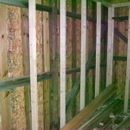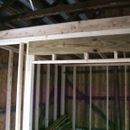Pole barn fiberglass insulation help…
I have farmed a shop inside my pole barn. I have 6mil plastic under the concrete by no insulation. I do not plan to to heat and cool it very often. Also, I was given 12 rolls of unlaced R25 fiberglass insulation. The siding has been up for over a year it does not leak. My plan is air seal the exterior walls with caulk and cans of spray foam. I also plan to use a 6mil vapor barrier over the fiberglass and behind the OSB interior walls. The rolls of fiberglass are 6 feet by 25 feet and 8″ thick. Can I install the fiberglass between the post and the new stud wall and leave the stud cavities empty or do I need to cut and fit in inside each cavity?
If I am wrong on all counts, how should I install the fiberglass. I have a friend coming over in the morning to help, so I’d like to do it right the first time.
GBA Detail Library
A collection of one thousand construction details organized by climate and house part












Replies
James,
You don't mention your climate zone, so it's hard to know whether interior polyethylene makes sense. In most U.S. climate zones, it makes sense to skip the interior poly. (The exceptions would be parts of Alaska, northern Minnesota, northern Maine, or far northern New York state or Vermont.)
You should use a high-quality tape to seal the OSB seams. You need to aim for an airtight installation.
Fiberglass batts are not the best choice for insulation. Ideally, the batts should be carefully cut to fit your cavity exactly, so there are no air pockets. That will be very difficult. Here is more information: Installing Fiberglass Right.
I am in Maryland. The 2x4 framing is 6"-8" off the deterioration siding. If I fill the cavity, can I leave the space between the batt and siding empty?
Exterior siding not deterioration siding.
james: what are you doing outside to keep the weather off the osb? rainscreen? tyvek? if the fiberglass is exposed by any amount, circulating air will deteriorate its effectiveness. were it mine, i'd fill both the space and in between the studs. once you use up the free fiberglass, i think roxul would be a better choice for the rest. maybe the pros have a different opinion....
James,
Ideally, you need an air barrier on all six sides of each fiberglass batt.
Q. "If I fill the cavity, can I leave the space between the batt and siding empty?"
A. If you intend to install the insulation only between the new studs -- and not between the post framing -- then you should have installed an air barrier (plywood or OSB) on the exterior side of your new stud wall before you lifted the wall into place. It's now going to be much more awkward to install the necessary exterior air barrier on your new stud wall.
Thanks. I understand.
James
The exterior siding is lp smart side and primed and painted. It looks like osb only on the inside.
Since my last post I have taken inventory of the insulation and I have caulked and foam sealed the wall cavity. I have 432 SF of wall to insulate and I have 600 SF of R13 with vinyl facing plus 1440 SF of R25 un-faced. In addition I have 2" blue board insulation and 13 cases of commercial flexible sealant. I also plan to cover floor area inside the wall with 2" rigid foam board so that the fiberglass does touch the floor. I have completely enclosed the top of the wall with plywood. I have also filled all cracks and openings with canned spray insulation and flexible caulking. My shop area is for very occasional use when I need to make a repair around the property. I am more concerned with controlling humidity than I am with heating and cooling. The is a 288 SF space inside a 2000 SF barn. I need to get my tools out of the house and into a humidity controlled area so they will not rust.
Here are the pictures from top to bottom:
1. Blue board with foam and caulking
2. Caulking over panel seams which also have 1x4 boards on the outside which have also been caulked and sealed.
3. Splash board sealing
4. Canned foam at the top of the walls
5. Foam sealant at the top of the wall and caulking under the plywood and all seams. I have also caulked everywhere two materials meet.
I understand that my situation is not ideal but I really need to get the best out of where I am now and what materials I have on hand. Will I get any benefit out of attaching the vinyl fiberglass blankets to the exterior with furring strips at the top, bottom, and all sides? It will leave a 3" cavity between the siding and the fiberglass blanket because of the girts and posts but the vinyl laminate should seal the air between the interior and exterior. I will also caulk the OSB to the studs at the walls and ceiling. My goal is to seal all cracks and opening between the exterior siding and the interior walls. I hope to stop all air movement inside the walls. Finally, my wife and I are putting on a house addition in the spring and she wants me to safe the R25 fiberglass for her pet project.